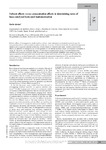Mostrar o rexistro simple do ítem
Solvent Effects versus Concentration Effects in determining Rates of Base-catalysed Keto-enol Tautomerization
| dc.contributor.author | Iglesias, Emilia | |
| dc.date.accessioned | 2005-11-21T17:09:30Z | |
| dc.date.available | 2005-11-21T17:09:30Z | |
| dc.date.issued | 2005 | |
| dc.identifier.citation | New Journal of chemistry, 2005, 29, p. 625-632 | es_ES |
| dc.identifier.uri | http://hdl.handle.net/2183/291 | |
| dc.description.abstract | Solvent effects of homogeneous media (such as solvent-water mixtures) in chemical reactivity may be interpreted as due to solvent polarity and/or molecular structure of solvent molecules. In microheterogeneous media (such as aqueous micellar solutions), solvent effects in reaction rates must include concentration effects, in addition to changes in the solvent polarity of the micelle interface where the reaction is assumed to occur. In this work, we measured rates of keto-enol tautomerization in 2-acetyl-cyclohexanone (ACHE) and 2-acetyl-1-tetralone (ATLO) systems performed in dimethylsulfoxide (DMSO)-water mixtures and in aqueous micellar solutions of both anionic and cationic surfactants carried out in the presence of buffers. The results appear as an ideal framework to understand the paramount importance of the specific molecular structure of solvent molecules in determining chemical reactivity versus solvent polarity or even concentration effects. | es_ES |
| dc.description.sponsorship | Ministerio de Ciencia y Tecnología; BQU2000-0239-C02-01 | |
| dc.description.sponsorship | Ministerio de Ciencia y Tecnología; BQU2003-04775-C02-01) | |
| dc.format.mimetype | application/pdf | |
| dc.language.iso | eng | es_ES |
| dc.publisher | Royal Society of Chemistry | es_ES |
| dc.subject | Tautomerization | es_ES |
| dc.subject | DMSO | |
| dc.subject | 2-acetylcyclohexanone | |
| dc.title | Solvent Effects versus Concentration Effects in determining Rates of Base-catalysed Keto-enol Tautomerization | es_ES |
| dc.type | info:eu-repo/semantics/article | es_ES |
| dc.rights.access | info:eu-repo/semantics/openAccess | es_ES |
Ficheiros no ítem
Este ítem aparece na(s) seguinte(s) colección(s)
-
GI-CS - Artigos [11]






